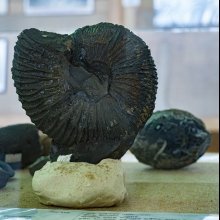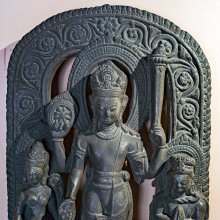Shaligrama, Śāligrāma, Shali-grama: 6 definitions
Introduction:
Shaligrama means something in Hinduism, Sanskrit, Jainism, Prakrit, Marathi. If you want to know the exact meaning, history, etymology or English translation of this term then check out the descriptions on this page. Add your comment or reference to a book if you want to contribute to this summary article.
The Sanskrit term Śāligrāma can be transliterated into English as Saligrama or Shaligrama, using the IAST transliteration scheme (?).
Images (photo gallery)
In Hinduism
Purana and Itihasa (epic history)
Source: Wisdom Library: Skanda-puranaŚāligrāma (शालिग्राम) refers to a type of stone used for the worship of Viṣṇu, according to the Skandapurāṇa 6.1.243.—Accordingly, “[...] Enjoyment of pleasures (and salvation) cannot be far from those men who always worship Viṣṇu in Śāligrāma, the Lord marked by his discus (or Śāligrāma which is marked by discus). Whatever auspicious rite is performed (especially during Cāturmāsya) with the mind dwelling on Śāligrāma, shall be everlasting in its benefit. Salvation is not inaccessible to a man who has acquired association with both, viz. a Śāligrāma stone and a Dvārāvatī stone. [...]”.
There are twenty-four types of Śāligrāma stones mentioned in the succeeding chapter:
- Keśava,
- Madhusūdana,
- Saṅkarṣaṇa,
- Dāmodara,
- Vāsudeva,
- Pradyumna,
- Viṣṇu,
- Mādhava,
- Anantamūrti,
- Puruṣottama,
- Adhokṣaja,
- Janārdana,
- Govinda,
- Trivikrama,
- Śrīdhara,
- Hṛṣīkeśa,
- Nṛsiṃha,
- Viśvayoni,
- Vāmana,
- Nārāyaṇa,
- Puṇḍarīkākṣa,
- Upendra,
- Hari,
- Kṛṣṇa.

The Purana (पुराण, purāṇas) refers to Sanskrit literature preserving ancient India’s vast cultural history, including historical legends, religious ceremonies, various arts and sciences. The eighteen mahapuranas total over 400,000 shlokas (metrical couplets) and date to at least several centuries BCE.
In Jainism
General definition (in Jainism)
Source: archive.org: TrisastisalakapurusacaritraSāligrāma (सालिग्राम) is the name of an ancient village, according to chapter 2.3 [ajitanātha-caritra] of Hemacandra’s 11th century Triṣaṣṭiśalākāpuruṣacaritra: an ancient Sanskrit epic poem narrating the history and legends of sixty-three illustrious persons in Jainism.
Accordingly, as Ajita narrated:—“[...] Not very far from this city is a large village granted to Brahmans, named Sāligrāma. There lived the head of the Brāhmans, named Dāmodara, and his wife Somā. They had a son Śuddhabhaṭṭa who married Sulakṣaṇā, the daughter of Siddhabhaṭṭa. Sulakṣaṇā and Śuddhabhaṭṭa grew up and enjoyed pleasures suitable to their position, as they liked. In course of time their parents died, and their fathers’ money also disappeared. Sometimes he would lie down at night, hungry in the midst of plenty”.

Jainism is an Indian religion of Dharma whose doctrine revolves around harmlessness (ahimsa) towards every living being. The two major branches (Digambara and Svetambara) of Jainism stimulate self-control (or, shramana, ‘self-reliance’) and spiritual development through a path of peace for the soul to progess to the ultimate goal.
Languages of India and abroad
Marathi-English dictionary
Source: DDSA: The Molesworth Marathi and English Dictionaryśāligrāma (शालिग्राम).—m (śāla S River, and grāvā S Stone.) A black stone found in the river gaṇḍakī and worshiped as sacred to Vishn̤u. 2 fig. (Because it resembles this stone in shape.) A jocose name for the onion.
Source: DDSA: The Aryabhusan school dictionary, Marathi-Englishśāligrāma (शालिग्राम).—m A blackstone found in the gaṇḍakī & worshipped as viṣṇu.
Marathi is an Indo-European language having over 70 million native speakers people in (predominantly) Maharashtra India. Marathi, like many other Indo-Aryan languages, evolved from early forms of Prakrit, which itself is a subset of Sanskrit, one of the most ancient languages of the world.
Sanskrit dictionary
Source: DDSA: The practical Sanskrit-English dictionaryŚāligrāma (शालिग्राम).—(s. v. śālagrāmaḥ above); शालिग्रामशिलानां च दानानां च निरूपणम् (śāligrāmaśilānāṃ ca dānānāṃ ca nirūpaṇam) Brav. P. ब्रह्मखण्ड (brahmakhaṇḍa) 1.28.
Derivable forms: śāligrāmaḥ (शालिग्रामः).
Śāligrāma is a Sanskrit compound consisting of the terms śāli and grāma (ग्राम).
Sanskrit, also spelled संस्कृतम् (saṃskṛtam), is an ancient language of India commonly seen as the grandmother of the Indo-European language family (even English!). Closely allied with Prakrit and Pali, Sanskrit is more exhaustive in both grammar and terms and has the most extensive collection of literature in the world, greatly surpassing its sister-languages Greek and Latin.
Kannada-English dictionary
Source: Alar: Kannada-English corpusŚāligrāma (ಶಾಲಿಗ್ರಾಮ):—[noun] = ಶಾಲಗ್ರಾಮ [shalagrama].
--- OR ---
Sāligrāma (ಸಾಲಿಗ್ರಾಮ):—[noun] a kind of ammonite or fossil of an extinct species of molluscs, found mainly along the river Gandaki, which represents Viṣṇu.
Kannada is a Dravidian language (as opposed to the Indo-European language family) mainly spoken in the southwestern region of India.
See also (Relevant definitions)
Partial matches: Shali, Grama.
Full-text: Shalagrama, Gandakishila, Gandakiputra, Saligrava, Sudarshana, Damodara, Shuddhabhatta, Nilamli, Shaligram, Soma, Siddhabhatta, Tankari, Santa, Kshetra, Cakra, Sulakshana, Abhisheka.
Relevant text
Search found 11 books and stories containing Shaligrama, Śāligrāma, Saligrama, Shali-grama, Śāli-grāma, Sali-grama, Śaligrāma, Sāligrāma; (plurals include: Shaligramas, Śāligrāmas, Saligramas, gramas, grāmas, Śaligrāmas, Sāligrāmas). You can also click to the full overview containing English textual excerpts. Below are direct links for the most relevant articles:
The Skanda Purana (by G. V. Tagare)
Chapter 244 - Twenty-four Varieties of Śāligrāma < [Section 1 - Tīrtha-māhātmya]
Chapter 243 - Importance of Śāligrāma Worship < [Section 1 - Tīrtha-māhātmya]
Chapter 39 - The eminence of religious vow (vrata) of the twelfth Day < [Section 4 - Dvārakā-māhātmya]
The Legend of the Holy Basil or Tulsi < [July – September, 2004]
Sri Raghavendra Swami < [January – March, 2007]
Masti: The Man and the Man of Letters < [October – December, 1984]
Atharvaveda and Charaka Samhita (by Laxmi Maji)
Treatment of Mental illness < [Chapter 3 - Diseases and Remedial measures (described in Atharvaveda)]
The Matsya Purana (critical study) (by Kushal Kalita)
Part 3b - Tīrthas recommended for Śrāddhas < [Chapter 8 - Geographical data in the Matsyapurāṇa]
Trishashti Shalaka Purusha Caritra (by Helen M. Johnson)
Part 11: Origin of Dhūmaketu’s enmity < [Chapter VI - Marriage of Kṛṣṇa with Rukmiṇī and others]
Part 4: Story of Durgandhā < [Chapter VII - The stories of Celaṇā’s one-pillared palace]
Part 35: Story of the Brāhman converts < [Chapter III - The initiation and omniscience of Ajita]
The Padma Purana (by N.A. Deshpande)
One hundred and eight (108) names of Sāvitrī < [Section 1 - Sṛṣṭi-khaṇḍa (section on creation)]
Chapter 5 - The Consecration of Indra < [Section 2 - Bhūmi-khaṇḍa (section on the earth)]
Chapter 47 - The Birth of Garuḍa < [Section 1 - Sṛṣṭi-khaṇḍa (section on creation)]



